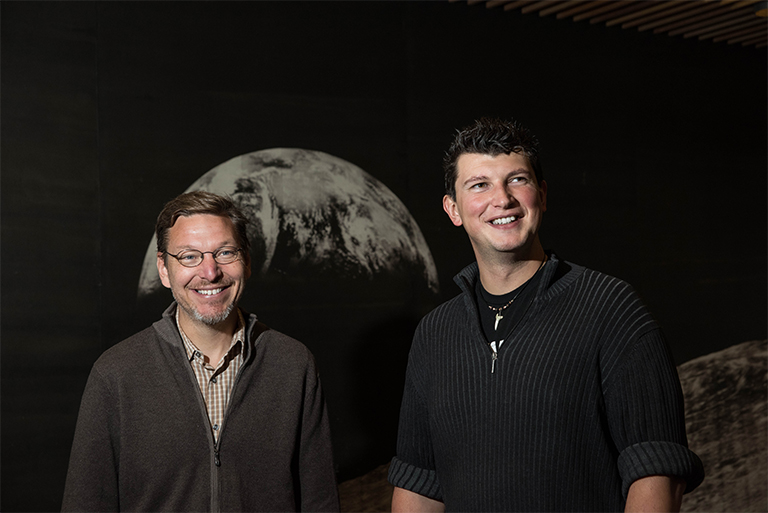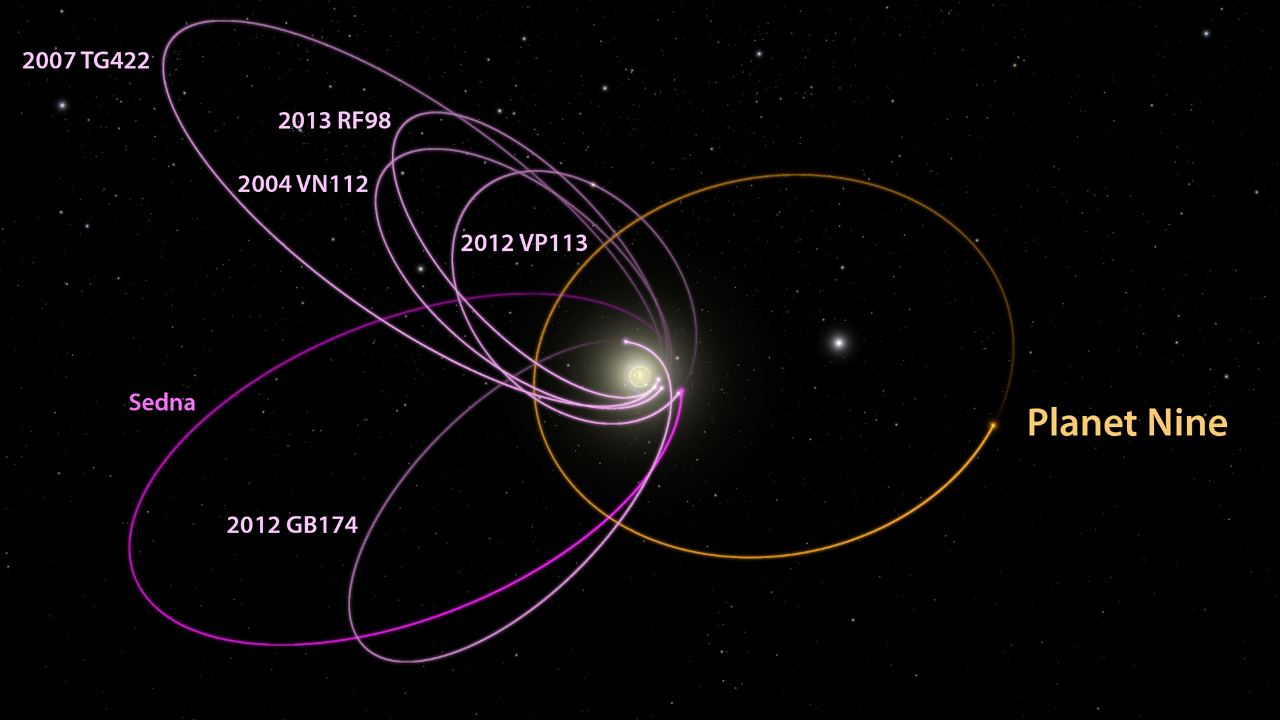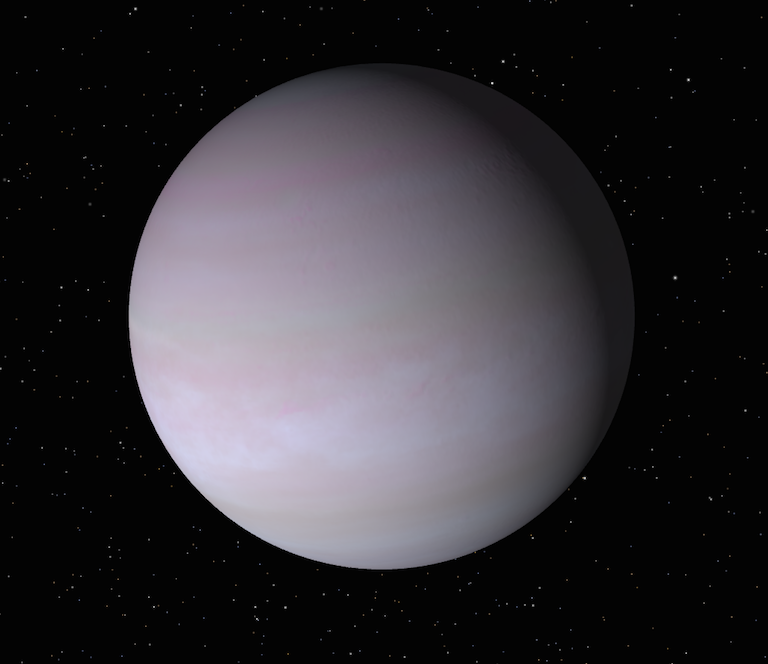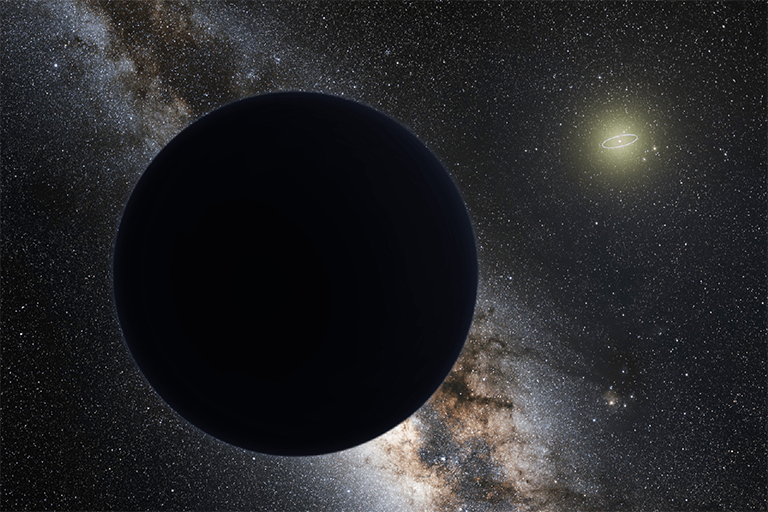Alien vs. Editor ranges across our galaxy, paying brief visits to exotic worlds orbiting other suns. We see these exoplanets through space and ground-based telescopes, the eyes of scientists, and the imaginary flights of artists, filmmakers and the occasional visionary.
Alien Vs. Editor | March 20, 2018
The planet that wasn't there (Oh, wait, it was)
A massive gas giant more weighty than Jupiter, orbiting an orange star some 45 light years away, might be the most important exoplanet you’ve never heard of.
A massive gas giant more weighty than Jupiter, orbiting an orange star some 45 light years away, might be the most important exoplanet you've never heard of.
The planet, called Gamma Cephei A b – "Tadmor" for short – achieved its 15 minutes of fame in 1988. At least, among astronomers. It was the first planet to be discovered outside our solar system.
Or it would have been. The discovery was withdrawn by the Canadian team that announced it in 1992, after the data backing it up was determined to be too wobbly for astronomers to be sure the planet was real. Tadmor was added to a growing list of mistaken exoplanet detections that began as far back as the 19th century.
In this case, "wobbly" turns out to be the right word. The astronomers who thought they'd found the first exoplanet had developed a technique that allowed them to track the subtle motions of stars. The amount of "wobble" would reveal the mass of an object orbiting the star, tugging it first this way, then that. The researchers' major advance was precision measurement – capturing stellar movements as small as 43 feet (13 meters) per second. That kind of precision was needed to pick up the tiny wobbles, back and forth, that a large orbiting planet caused the star to make.
Despite their advance, the research team, Bruce Campbell, Gordon Walker and Stephenson Yang, worried that periodic changes in the star's magnetic activity might have looked to them like the gravitational tugs of a planet – in other words, that they might have mistaken jitters within the star for a planet in orbit around it.
They bid goodbye to Tadmor.
Riffle forward through the calendar, and stop in 2002. On-again, off-again Tadmor was on again – this time, its presence solidly confirmed. A team of astronomers that included the original discoverers captured strong evidence of the planet. They used four separate data sets from high-precision "wobble" measurements, known as radial velocity, spanning the period from 1981 to 2002.
The radial velocity method today has notched hundreds of exoplanet discoveries. It's been overshadowed only by the "transit" method, responsible for thousands, that looks for a tiny dip in the light from a star as a planet passes in front of it.
And although the list of confirmed exoplanets was just beginning to grow in the early 2000s, Tadmor already had been eclipsed. A planet called 51 Pegasi b, discovered by Michel Mayor and Didier Queloz, stole most of the spotlight in 1995. It was the first confirmed exoplanet detection to capture worldwide public attention.
Tadmor, of course, continues to orbit its big orange sun, somewhere in the constellation Cepheus, presumably unaware of its near-fame on a small blue planet dozens of light-years away. Time rolls on. Happy 30th anniversary, Tadmor.
Alien Vs. Editor | October 6, 2017
Planet Nine
The super Earth that came home for dinner
It might be lingering bashfully on the icy outer edges of our solar system, hiding in the dark, but subtly pulling strings behind the scenes: stretching out the orbits of distant bodies, perhaps even tilting the entire solar system to one side.
If a planet is there, it’s extremely distant and will stay that way (with no chance – in case you’re wondering – of ever colliding with Earth, or bringing “days of darkness”). It is a possible Planet Nine, a world perhaps 10 times the mass of Earth and 20 times farther from the sun than Neptune. The signs so far are indirect, mainly its gravitational footprints, but that adds up to a compelling case nonetheless.
One of its most dedicated trackers, in fact, says it is now harder to imagine our solar system without a Planet Nine than with one.
“There are now five different lines of observational evidence pointing to the existence of Planet Nine,” said Konstantin Batygin, a planetary astrophysicist at Caltech whose team may be closing in. “If you were to remove this explanation, and imagine Planet Nine does not exist, then you generate more problems than you solve. All of a sudden, you have five different puzzles, and you must come up with five different theories to explain them.”
Batygin and his co-author, Caltech astronomer Mike Brown, described the first three breadcrumbs on Planet Nine’s trail in a January 2016 paper, published in the Astronomical Journal. Six known objects in the distant Kuiper Belt, a region of icy bodies stretching from Neptune outward toward interstellar space, all have elliptical orbits pointing in the same direction. That would be unlikely – and suspicious – enough. But these orbits also are tilted the same way, about 30 degrees “downward” compared to the pancake-like plane within which the planets orbit the sun.

Breadcrumb number three: Computer simulations of the solar system with Planet Nine included show that there should be more objects tilted with respect to the solar plane. In fact, the tilt would be on the order of 90 degrees, as if the plane of the solar system and these objects formed an “X” when viewed edge-on. Sure enough, Brown realized that five such objects already known to astronomers fill the bill.
Two more clues emerged after the original paper. A second article from the team, this time led by Batygin’s graduate student, Elizabeth Bailey, showed that Planet Nine could have tilted the planets of our solar system during the last 4.5 billion years. This could explain a longstanding mystery: Why is the plane in which the planets orbit tilted about 6 degrees compared to the sun's equator?
“Over long periods of time, Planet Nine will make the entire solar-system plane precess or wobble, just like a top on a table,” Batygin said.
The last telltale sign of Planet Nine’s presence involves the solar system’s contrarians: objects from the Kuiper Belt that orbit in the opposite direction from everything else in the solar system. Planet Nine’s orbital influence would explain why these bodies from the distant Kuiper Belt end up “polluting” the inner Kuiper Belt.
“No other model can explain the weirdness of these high-inclination orbits,” Batygin said. “It turns out that Planet Nine provides a natural avenue for their generation. These things have been twisted out of the solar system plane with help from Planet Nine and then scattered inward by Neptune.”

The remaining step is to find Planet Nine itself. Batygin and Brown are using the Subaru Telescope in Hawaii’s Mauna Kea Observatory to try to do just that. The instrument is the “best tool” for picking out dim, extremely distant objects lost in huge swaths of sky, Batygin said.
But where did Planet Nine come from? Batygin says he spends little time ruminating on its origin – whether it is a fugitive from our own solar system or, just maybe, a wandering rogue planet captured by the sun’s gravity.
“I think Planet Nine’s detection will tell us something about its origin,” he said.
Other scientists offer a different possible explanation for the Planet Nine evidence cited by Batygin. A recent analysis based on a sky mapping project called the Outer Solar System Origins Survey, which discovered more than 800 new “trans-Neptunian objects,” or TNOs, suggests that the evidence also could be consistent with a random distribution of such objects. Still, the analysis, from a team led by Cory Shankman of the University of Victoria, could not rule out Planet Nine.
If Planet Nine is found, it will be a homecoming of sorts, or at least a family reunion. Over the past 20 years, surveys of planets around other stars in our galaxy have found the most common types to be “super Earths” and their somewhat larger cousins – bigger than Earth but smaller than Neptune.
Yet these common, garden-variety planets are conspicuously absent from our solar system. Weighing in at roughly 10 times Earth’s mass, the proposed Planet Nine would make a good fit.
Planet Nine could turn out to be our missing super Earth.
TAGS: PLANET NINE, PLANET, KUIPER BELT
Alien Vs. Editor | March 30, 2012
A Pigment of Your Imagination?
Joel asked: If you were to find aliens next to the sun, why would they be blue?
The only blue aliens I'm aware of lived on a moon called Pandora in a popular movie released in 2009. The foundation of your question is the more general question of why we observe a wide variety of colors "used" by life on Earth. Those colors are "used" by their organisms in many different ways. And there are a variety of mechanisms that generate the colors.
The colors of plants and animals have a variety of goals. For plants, the green of their leaves comes from the chlorophyll that absorbs violet-blue and yellow-orange-red light for photosynthesis. Some plants (like Japanese plum) have additional pigments for protection from ultraviolet light and appear dark red. Flowers have colors specifically to attract pollinators, but the colors the pollinators see may not be the colors we see.
Animals have colors to camouflage themselves and attract mates. Some plant and animal coloring is designed to warn off predators. The red eye you see in flash pictures of your friends is a reflection of their eyes' retinas. Photographs of dogs show their retinas reflect greenish light. Is retinal color related to color vision? Most humans have color vision and dogs are color blind.
The colors we see around us are generated by different mechanisms, which can reflect (pun intended) on its use by an organism. The color of a pigment depends on the colors it absorbs and those it reflects. Chlorophyll is a green pigment, and hair and skin colors result from pigments as well.

Polar bears' black skin pigmentation helps keep them warm. The bears' white fur only looks white in bulk. Individual hair follicles are actually transparent, so that they carry sunlight down from the "top" of the fur coat to the bear's skin, where all the colors of sunlight (you've seen them in a rainbow made by differential refraction, another mechanism!) are absorbed by the black skin, helping to keep the polar bear warm. The fiber optics we use to transfer data over the internet or between components in your home entertainment system carry light in the same way.
The iridescent color of bird feathers is produced by another mechanism, the same one that makes detergent bubbles and thin slicks of oil on water show colors. The structure of feathers and thickness of detergent and oil layers permits waves of light to "interfere" with each other. You've seen wave interference in a quiet pool or pond when you throw two small objects into the water and the circular waves move out from each impact point. When the waves cross over each other, their height is greater where the peaks combine and flat where a peak and a valley combine.
A similar thing happens with light waves in iridescent materials. In the feathers, waves of a particular color are reflected and combined before they are shunted out of the feather, while the other colors are absorbed by a black pigment. The colors come from the spacing of tiny reflectors, called lamellae, in the feathers: change the spacing and the color coming from the feather is different. In detergent bubbles and oil slicks, change the layer's thickness and you change the color seen.
So where might we expect blue-skinned aliens? My answer is on an exoplanet orbiting a cool, red star. Why? Because the alien probably wants to absorb as much stellar energy as it can from its star, and blue pigments absorb red light. It would be well-camouflaged in the blue vegetation trying to absorb as much energy from the red sun as it could.
TAGS: EXOPLANETS, ASTROPHYSICS, EXTRATERRESTRIAL LIFE, UNIVERSE







